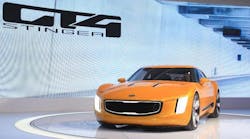US Carmakers use Aluminum, Carbon Fiber to Cut Weight
DETROIT -- More vehicles than ever on display at the Detroit auto show are using non-traditional materials -- aluminum, carbon fiber, magnesium -- as U.S. automakers fight to get vehicle weight down and gas mileage up.
Ford's introduction of aluminum body panels for its workhorse F150 pickup truck was a radical shift which it said would knock up to 700 pounds from the truck's weight.
But it presents a challenge to discerning buyers who are accustomed to the country's premier pickup being built with solid steel, but also straining under high fuel costs.
"It's become critical. Carmakers are leaving no stone unturned while looking for ways to take weight out of the vehicle," said General Motors spokesman Dan Flores.
GM also unveiled in Detroit a new version of its Corvette supercar that is 110 pounds lighter than its predecessor, thanks to an "exclusive" technology for eliminating rivets to directly spot-weld aluminum components.
In Europe, where fuel is far more expensive, non-steel components are not new. Indeed, in the 1930s, the luxurious Bugatti was made with aluminum, and Audi used the material in its cars in the 1990s.
But with the Ford F150, said independent industry analyst Bertrand Rakoto, "it is new and ambitious on a work vehicle, because it will be dented and is more expensive to repair."
"You have to have a service network equipped with special tools and forms."
Pickup truck rivals were keeping their eye on Ford's move, without saying if they will follow suit.
"For our customers, gasoline is a cost. This is a work truck. Fuel costs are a very important part of their overall equation," said Ford Executive Chairman Bill Ford.
Besides the risk of alienating the builders and farmers who are traditional F150 buyers, Ford has taken a risk with aluminum itself, now cheap but with a history of big price swings that has often made steel a better alternative.
That could be a problem, said Rakoto, especially "if everyone turns to aluminum."
Not all see aluminum as the solution for vehicle weight issues, however. "There are a lot of approaches to light weight," said Art St. Cyr, American Honda's vice president for product planning. "We have used aluminum in hoods, fenders. But we have been able to achieve weight reduction with ultra-high strength steel."
Plastic, too, has proven an alternative for things like auto bumpers, because it will scrape and dent but not break in parking lot collisions.
Strong, ultra-light carbon fiber is also becoming a material of choice for some parts and trim, though it is costly.
Kia's new small sports car, the GT4 Stinger, was unveiled in Detroit with carbon fiber wheel rims and body trim.
BMW's electric i8 sports car racer is heavily built with carbon fiber, including the interior.
Alec Gutierrez, an analyst with Kelly Blue Book, said that carbon fiber would become more widespread only when the price falls. Rakoto added that another problem is how to recycle the material.
Automakers are also working with fiberglass, Kevlar and titanium. But everything comes back to cost.
"There is no silver bullet. It's not all about substituting a material for another -- it's also about engineering," said GM senior executive Mark Reuss.
But he acknowledged that he was watching closely Ford's F150 experiment.
-Veronique Dupont, AFP
Copyright Agence France-Presse, 2014




